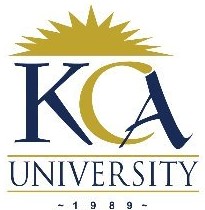 UNIVERSITY EXAMINATIONS: 2012/2013
UNIVERSITY EXAMINATIONS: 2012/2013
FIRST YEAR EXAMINATION FOR THE BACHELOR OF SCIENCE
IN INFORMATION TECHNOLOGY
BIT 4302 TELECOMMUNICATIONS
DATE: DECEMBER, 2012 TIME: 2 HOURS
INSTRUCTIONS: Answer Question ONE and any other TWO
QUESTION ONE
a) GPRS is a wireless Packet Switched Data. State any four of its characteristics.
(4 Marks)
b) Identify the four components of a telecommunication system. (4 Marks)
c) Define the following terminologies as used in telecommunications:
i. Simplex (1 Mark)
ii. Half Duplex (1 Mark)
iii. Full Duplex (1 Mark)
iv. Connection-oriented network service (1 Mark)
v. Connectionless-oriented network service (1 Mark)
d) PCM (Pulse Code Modulation) is the process in which a signal is sampled, and
the magnitude of the each sample with respect to a fixed reference is quantized
and converted by coding to a digital signal.
i. Define sampling, quantization and encoding. (3 Marks)
ii. State Nyquist Sampling Theorem (2 Marks)
iii. Voice has frequency ranging from (approximately) 0 to 4000 Hz. To reconstruct
the signal when digitized, at what rate should samples be taken? (1 Mark)
e) Explain briefly three features of
i. circuit switching. (3 Marks)
ii. Packet switching (3 Marks)
f) Compare and contrast fibre and satellite transmission systems. (5 Marks)
QUESTION TWO
a) What are the benefits of teleworking? (4 Marks)
b) Explain briefly four techniques that can be used to increase capacity in mobile
networks. (4 Marks)
c) “Multiple access” is a phrase commonly used with communication systems.
i. Define the term “Multiple Access”. (1 Mark)
ii. Identify the key differences between the following types of multiple access:
FDMA; TDMA; CDMA. (3 Marks)
d) With the aid of simple diagrams, sketch and show the minimum distance between
the centers of the cells that use the same frequency in the following cases:
i. frequency re-use for 4-cell re-use pattern (4 Marks)
ii. frequency re-use for 7-cell re-use pattern (4 Marks)
QUESTION THREE
a) Discuss any three key transmission impairments. (6 Marks)
b) Computer network designers must often rely on the existing telecommunications
facilities; this implies that the telephone systems is tightly intertwined with wide
area networks (WANs).
i. Using a diagram, show the basic structure of the Public Switched Telephone
Network (PSTN) and identify the most bandwidth-constrained portion of the
network. (5 Marks)
ii. The PSTN is the best-known example of networks using circuit switching. Give
your understanding of circuit switching, and explain its suitability for use with the
PSTN. (2 Marks)
iii. Telecommunications systems use transmission media of various types. Explain
why, with any communications medium, the received signal will differ from the
transmitted signal. (3 Marks)
c) The WAN access physical layer describes the physical connection between the
company network and the service provider network. Describe the following as
commonly used to describe physical WAN connections:
i. CPE (2 Marks)
ii. DCE (2 Marks)
QUESTION FOUR
a) TCP/IP protocols had several important features that allowed them to meet the
need for worldwide data communication. Explain briefly any three of these
features. (3 Marks)
b) You are experiencing intermittent issues relating to congestion with your network.
What are the possible causes of congestion on a LAN? (4 Marks)
c) Communication between individuals is determined to be successful when the
meaning of the message understood by the recipient matches the meaning
intended by the sender. State five external factors that affect the success of
communication. (5 Marks)
d) i. Define the term convergence as used in Computer networks (2 Marks)
ii. Converged networks have existed for a while now, but were only feasible
in large enterprise organizations. Why? (4 Marks)
iii. Why is it difficulty for some organizations to make a decision to move
towards converged networks? (2 Marks)
QUESTION FIVE
a) IEEE 802.11 is the standard that specifies connectivity for wireless networks.
IEEE 802.11, or Wi-Fi, refers to a collective group of standards. These protocols
specify the frequencies, speeds, and other capabilities of the different Wi-Fi
standards. In this regard, describe the following standards:
i. IEEE 802.11a (2 Marks)
ii. IEEE 802.11b (2 Marks)
iii. IEEE 802.11g (2 Marks)
b) The 802.11 standard states that each conformant wireless LAN must provide nine
services. These services are divided into two categories: five distribution services
and four station services. The distribution services relate to managing ce11
membership and interacting with stations outside the cell. In contrast, the station
services relate to activity within a single cell and deal with station mobility as they
enter and leave cells, attaching themselves to and detach themselves from base
stations.
i. Describe each of the five distribution services. (5 Marks)
ii. Describe each of the four station services. (4 Marks)
c) Define the following terms as used in communication systems:
i. Attenuation (1 Mark)
ii. Noise (1 Mark)
iii. Distortion (1 Mark)